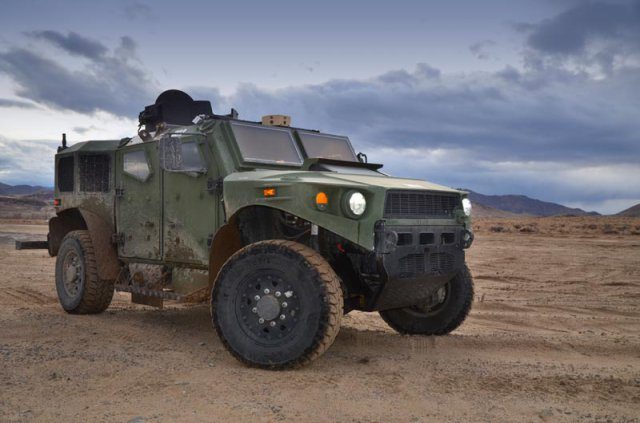Two of the three vehicles in the Army’s “Ultra Light Vehicle” program have now entered survivability testing in Nevada and Maryland, to evaluate both their blast and ballistic protection capability.
The third vehicle remains at the Army’s Tank Automotive Research, Development and Engineering Center, known as TARDEC, for testing there.
The TARDEC began development of three Ultra Light Vehicles, or ULVs, in fall 2011, at the request of the Office of the Secretary of Defense. While the ULV will not be fielded as a combat vehicle, it does serve as a research and development platform that will ultimately yield data that can be used by other TARDEC agencies and program managers, as well as sister services to develop their own vehicles and equipment in the future.
“It’s all about sharing the data,” said Mike Karaki, the ULV’s program manager. “If we have an ability to share the data internally within TARDEC, and externally within the program managers and program executive offices, and beyond that with other government agencies, we will attempt to do that. It’s helping shape and inform future programs.”
Karaki said the ULV program might help development of survivability in future vehicles, and may also help development of other hybrid vehicles as well.
“You want to be able to use anything and everything you can from this program to help reduce the duplication of efforts in the future,” he said.
The ULV is a hybrid vehicle that includes lightweight advanced material armor, lightweight wheels and tires and other automotive systems, blast-mitigating underbody technology and advanced command, control, communications, computers, intelligence, surveillance and reconnaissance equipment inside.
“We tried to push the envelope in terms of state-of-the-art and out-of-the-box materials throughout the entire development process,” said Karaki.
The vehicle, from design to delivery, took only 16 months, Karaki said.
“We show there are some successes in the rapid design, development, fabrication and integration of the effort,” Karaki said. “It’s doable. It’s high risk and high reward. Can you do it in a rapid time frame? We’ve proven we can do that.”
The ULV is hybrid vehicle powered by a diesel engine that drives an electric generator. That generator in turn powers two electric motors that turn the wheels. Two electric motors provides redundancy should one of the motors fail.
Karaki said choosing a hybrid system came from the need to develop a more survivable vehicle for Soldiers. He said the contractor was concerned about how to make the vehicle perform better in a blast event, and came to the conclusion that a hybrid was the better choice.
Because it is a hybrid vehicle, it has none of the standard equipment underneath the vehicle. It features instead a “clean underbody” that makes it more capable of withstanding something like an explosion from an improvised explosive device.
“If you keep less equipment, accessories, systems underneath the vehicle, and you allow the underbody geometry to do what it needs to do — have a clean underbody — you will be able to improve your chances of being able to direct a blast away from the vehicle,” he said.
The primary customer for the ULV vehicle, which is a test vehicle, is the Office of the Secretary of Defense. The program came with four research objectives, which are a 4,500 pound payload, a vehicle weight of 14,000 pounds, protection that is comparable to the currently fielded mine-resistant ambush-protected vehicle, and a price of $250,000 each for a hypothetical 5,000-unit production run.
Karaki said the program is meeting or is expected to meet those objectives.
“On paper, the stuff upfront, the size, the weight, the cost, the timeframe, we checked those boxes,” he said. “The testing and evaluation of all these advanced survivability systems are in process right now.”
Two of three vehicles are undergoing survivability testing now. The third vehicle is in Warren, Mich., at TARDEC’s Ground Systems Power and Energy Laboratory undergoing automotive testing and to evaluate its hybrid electric setup. Karaki said eventually the two ULVs undergoing survivability testing will be destroyed as part of that testing. The third vehicle, the one at TARDEC, will be kept as a test platform.
The ULV is not a replacement for the Joint Light Tactical Vehicle program or the Humvee. It is an experimental vehicle used for testing purposes. The program will wrap up in fiscal year 2014.










